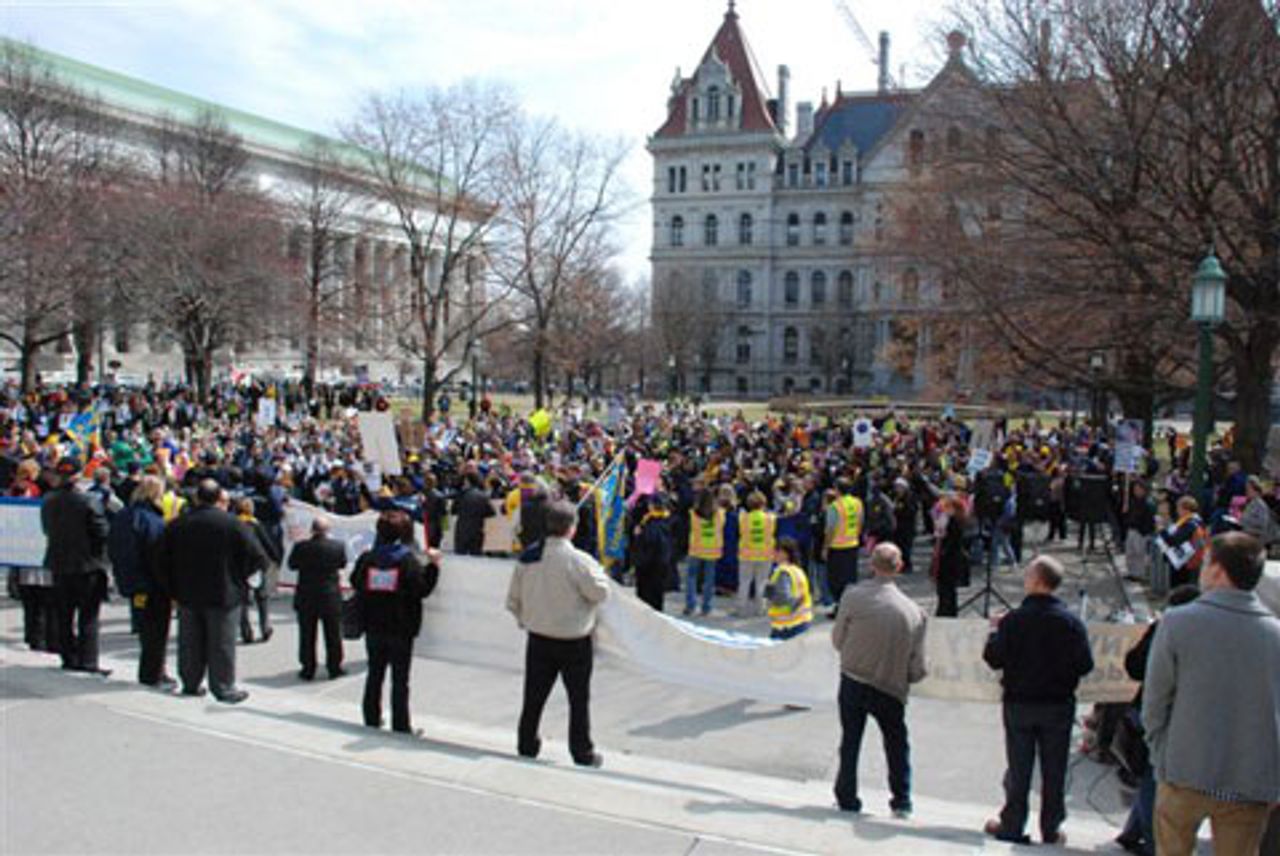Early Thursday morning, the New York State legislature largely adopted Democratic governor Andrew Cuomo’s proposal for a new “Tier VI” in the state’s pension program for newly hired state, county, and municipal employees.
The new Tier VI pension scheme was passed as part of the finalization of a budget deal for the new fiscal year, which begins on April 1. It will be in addition to the existing five tiers that have been instituted successively over the years, each one with poorer benefits and higher costs to workers than the one previous. Tier V was created only three years ago, in 2009, by the previous Democratic governor, David Paterson.
Adoption of Tier VI was opposed by the state’s public employee unions, which had mounted an extensive public relations campaign, including television, radio, and billboard advertisements, in the hope of pressuring Democrats in the legislature to reject Cuomo’s proposal. The adoption of the new pension tier by the legislature is yet another result of the unions’ unshakable collaboration with Democratic “friends of labor.” It follows major concessions made in last year’s labor contracts, which were forced onto the union memberships under the threat of nearly 10,000 layoffs. These contracts were endorsed by the union leaders as the best that could be hoped for.
The principal features of the new pension tier include:
• Employee pension contributions will rise from the current 3 percent to up to 6 percent for new employees making $45,000 a year or more, depending on income.
• Retirement age will rise from 62 to 63. Cuomo had wanted 65.
• Reduction in the formula used to calculate the amount pension benefits.
• After 30 years on the job, pensions will be 55 percent rather than the current 60 percent of employment income.
Higher paid, non-union employees as well as police and firefighters, are exempted from Tier VI.
Cuomo and his allies, prominent among whom is New York City’s billionaire mayor, Michael Bloomberg, have strongly pushed so-called pension reform under the pretext that public employee pensions are “out of control” and “overly generous,” and will soon bankrupt state and local governments.
Cuomo had stated that this was his top priority in 2012 and threatened to veto the budget if it passed the legislature without the new pension tier. This would have resulted in a government shutdown. “The question is, does this body, does this government, does this Legislature perpetuate a pension system that is on the verge of bankrupting the state…or does the Legislature respond to the needs of the people?” he had demanded.
A full-on propaganda war was waged by wealthy business and political interests and the capitalist media to convince the public that public employee pensions had to be curbed in order to avoid budgetary catastrophe resulting in mass layoffs. Governor Cuomo stated, “Without this critical reform, New Yorkers would have seen significant tax increases, as well as layoffs to teachers, firefighters and police.”
The media have been full of stories about egregious manipulation of the system by employees to boost their ultimate retirement compensation. The reality, however, is that the average annual retirement payment received by members of the Civil Service Employees’ Association (CSEA), the state’s largest public employee union, is $14,000, barely enough to survive on. Two thirds receive less than $20,000 a year. The average pension for state and local employees across the entire system is $18,300.
As the state comptroller has pointed out, the New York State public pension fund is currently fully funded and is one of the strongest such funds in the country. In recent years, however, the state and municipal governments have had to make increasingly large payments into the fund in order to keep it solvent. Cuomo and Bloomberg have both cited figures indicating that costs have risen sharply over the last decade and argued that this rate of increase will continue into the future, becoming a completely unmanageable burden on the taxpayers. According to Bloomberg, the city’s pension costs have risen from $1.5 to $8 billion over that time.
The reality that these politicians conveniently leave unstated is that the bulk of these increases have come since the financial crisis of 2008, when the value of the investments made by the pension fund declined substantially and government resources were used to make up the difference. According to Thomas DiNapoli, the state comptroller and sole trustee of the pension fund, “The higher contribution rates for employers have been driven primarily by the financial meltdown of 2008-9.” New York’s public pension funds lost $100 billion from 2007 to 2009.
Essentially, therefore, the pension cuts penalize public sector workers for Wall Street’s gambling losses and is but another prong in the capitalist drive to force the working class to pay for the economic crisis through the destruction of living standards. At the same time, corporate profits and executive compensation continue to increase while taxation of the financial and corporate elite is cut even further. Feeble calls by union bureaucrats last year to continue the “millionaire’s tax,” instituted at the height of the financial meltdown, were rejected by Cuomo and the legislature, handing the upper income brackets a significant windfall.
In a statement dripping with ruling class arrogance, the billionaire mayor of New York City commented that “if people don’t want to come to work for the city or the state, they don’t have to.”
Leaders of the state’s two largest public employee unions have called for legislation that would allow the public pension fund to sue to recover losses due to “Fraudulent and unethical financial practices on Wall Street….” Such legislation, even in the unlikely event that it was passed, has as much chance of being effectively implemented as other such measures—the “Dodd-Frank” financial reform law, for example, which has done nothing to change the reckless and destructive Wall Street practices that precipitated the 2008 crash.
Attacks on public employee pensions constitute a national trend. Forty-three states enacted major changes to retirement plans for public employees and teachers between 2009 and 2011, according to the National Conference of State Legislatures. This follows drastic reductions in pension benefits for workers in private firms, as for example in Obama’s so-called auto bailout.
Although state labor union leaders condemned the pension deal, their opposition has amounted to no more than lobbying the legislature and running a public relations campaign appealing to “fairness” and “reasonableness.”
Danny Donohue, the president of the CSEA, was quoted by The New York Times as complaining, “This deal is about politicians standing with the 1 percent—the wealthiest New Yorkers—to give them a better break while telling nurses, bus drivers, teachers, secretaries, and laborers to put up and shut up.”
Ken Brynien, the president of the Public Employees Federation (PEF), the second largest state worker union, said that his members “understand how it [the new pension tier] will undermine the high standards they work so hard to uphold throughout state service. The state has too few benefits to offer prospective employees now, with forced furloughs, rampant short-staffing and employee morale at rock-bottom lows.”
Both bureaucrats failed to mention that the conditions under which their members work are the result of contract concessions that they themselves endorsed.
 The rally in Albany
The rally in AlbanyOn Thursday, the PEF held a previously scheduled noon rally against attacks on state workers at the state capitol in Albany, with members bussed from around the state. Members of other state workers’ unions were present as well. The crowd appeared to number nearly a thousand.
The primary thrust of the union bureaucrats who spoke at the rally was that Tier VI is unfair because the politicians do not appreciate the value of the work done by state employees. They denounced the new pension tier and said that they would fight attacks on state workers. One speaker chanted, “The war is on!” However, nothing was said about how this struggle would actually be conducted, other than that politicians should beware at election time. This is a hollow threat. Union collaboration with the Democrats is unshakable, regardless of radical-sounding statements and feigned differences. In an attempt to separate the “good” Democratic legislators from the “bad” Democratic governor, PEF president Brynien claimed, “The governor is trying to undercut the legislators’ power to represent the New Yorkers who elect them.”
The PEF endorsed Cuomo when he ran for governor in 2010. When asked, after the acceptance of the concessions contract last year, whether he would do so again, the PEF president refused to give a clear answer. Brynien and the other union bureaucrats are deathly afraid that the continuous attacks on workers will drive them to reject both the Democrats and the union.
 Tom Allocco
Tom AlloccoThe WSWS spoke with workers at the rally. The changing conditions for the white-collar workers that the PEF represents were summed up by Tom Allocco, who works for the State Health Department.
“What I’m seeing here is that people who in the past have thought they had a stake in the system are learning that the system is so rough now that even they are being kicked off of the wagon. The determination of the capitalists and the greed of the corporations is actually now being felt by middle class people who thought they were protected from the worst aspects of capitalism gone rampant. They’re now talking about taking away people’s pensions, and some of the people can understand and feel the pain.”
With regard to the political situation, Tom said, “What I see is a Democrat Party that’s now in the same position, has the same policies as the Republican Party had maybe 30 years ago. So I don’t see a big choice among the two parties.”
